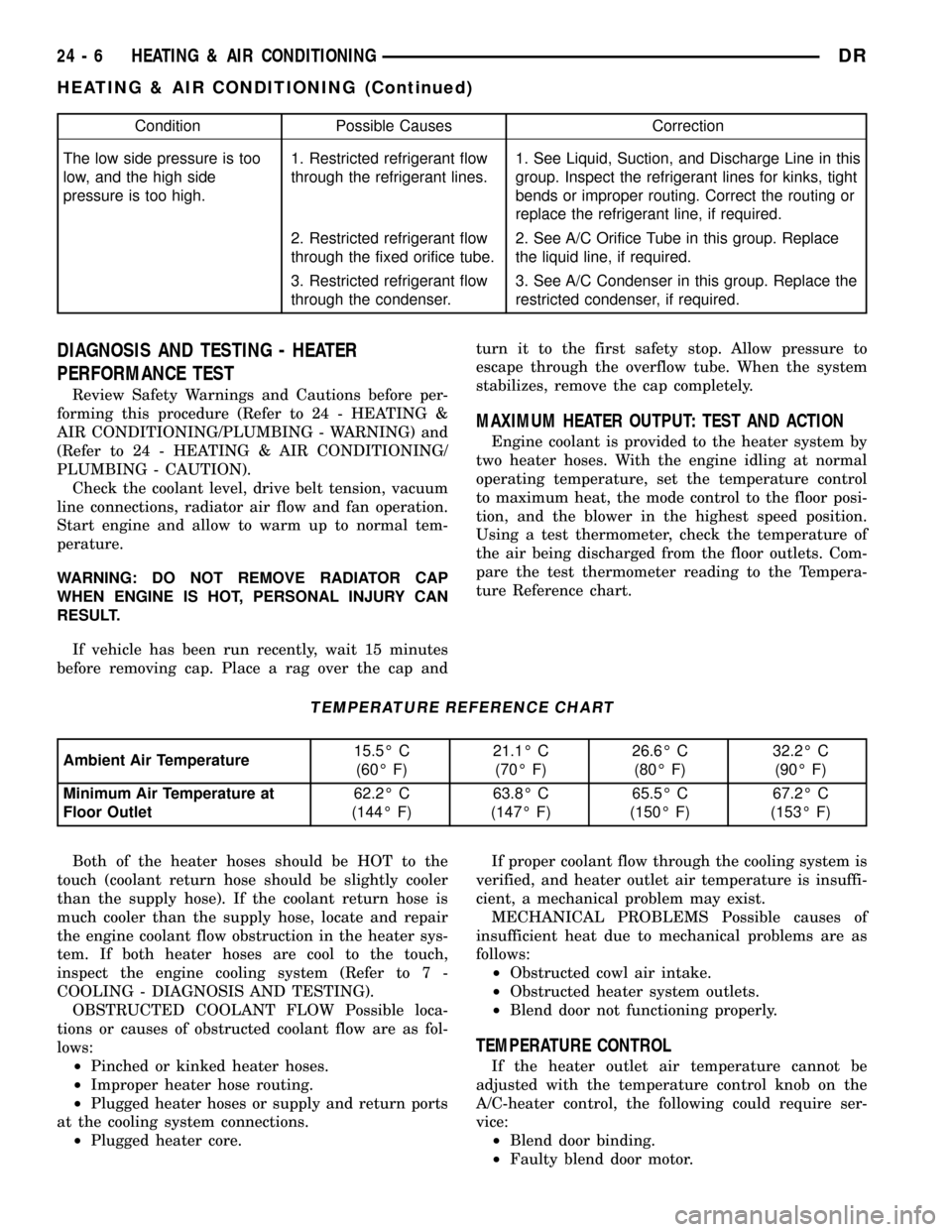1998 DODGE RAM 1500 No start diagnosis
[x] Cancel search: No start diagnosisPage 2490 of 2627

The panel outlets receive airflow from the HVAC
housing through a molded plastic main panel duct,
center panel duct and two end panel ducts. The two
end panel ducts direct airflow to the left and right
instrument panel outlets, while the center panel duct
directs airflow to the two center panel outlets. Each
of these outlets can be individually adjusted to direct
the flow of air.
The floor outlets receive airflow from the HVAC
housing through the floor distribution duct. The front
floor outlets are integral to the molded plastic floor
distribution duct, which is secured to the bottom of
the housing. The floor outlets cannot be adjusted.
The air conditioner for all models is designed for
the use of non-CFC, R-134a refrigerant. The air con-
ditioning system has an evaporator to cool and dehu-
midify the incoming air prior to blending it with the
heated air. This air conditioning system uses a fixed
orifice tube in the liquid line near the condenser out-
let tube to meter refrigerant flow to the evaporator
coil. To maintain minimum evaporator temperature
and prevent evaporator freezing, a evaporator tem-
perature sensor is used. The JTEC control module is
programmed to respond to the evaporator tempera-
ture sensor input by cycling the air conditioning com-
pressor clutch as necessary to optimize air
conditioning system performance and to protect the
system from evaporator freezing.
DIAGNOSIS AND TESTING
DIAGNOSIS AND TESTING - A/C
PERFORMANCE
The air conditioning system is designed to remove
heat and humidity from the air entering the passen-
ger compartment. The evaporator, located in the
HVAC housing, is cooled to temperatures near the
freezing point. As warm damp air passes over the
fins in the evaporator, moisture in the air condenses
to water, dehumidifying the air. Condensation on the
evaporator fins reduces the evaporators ability to
absorb heat. During periods of high heat and humid-
ity, an air conditioning system will be less effective.
With the instrument control set to Recirculation
mode, only air from the passenger compartment
passes through the evaporator. As the passenger com-
partment air dehumidifies, A/C performance levels
rise.
Humidity has an important bearing on the temper-
ature of the air delivered to the interior of the vehi-
cle. It is important to understand the effect that
humidity has on the performance of the air condition-
ing system. When humidity is high, the evaporator
has to perform a double duty. It must lower the air
temperature, and it must lower the temperature ofthe moisture in the air that condenses on the evapo-
rator fins. Condensing the moisture in the air trans-
fers heat energy into the evaporator fins and tubing.
This reduces the amount of heat the evaporator can
absorb from the air. High humidity greatly reduces
the ability of the evaporator to lower the temperature
of the air.
However, evaporator capacity used to reduce the
amount of moisture in the air is not wasted. Wring-
ing some of the moisture out of the air entering the
vehicle adds to the comfort of the passengers.
Although, an owner may expect too much from their
air conditioning system on humid days. A perfor-
mance test is the best way to determine whether the
system is performing up to standard. This test also
provides valuable clues as to the possible cause of
trouble with the air conditioning system.
PERFORMANCE TEST PROCEDURE
Review Safety Warnings and Cautions before per-
forming this procedure (Refer to 24 - HEATING &
AIR CONDITIONING/PLUMBING - WARNING) and
(Refer to 24 - HEATING & AIR CONDITIONING/
PLUMBING - CAUTION). Air temperature in test
room and on vehicle must be 21É C (70É F) minimum
for this test.
NOTE: When connecting the service equipment
coupling to the line fitting, verify that the valve of
the coupling is fully closed. This will reduce the
amount of effort required to make the connection.
(1) Connect a tachometer and a manifold gauge set
or A/C recycling/charging station.
(2) Set the A/C-heater mode control in the Recircu-
lation Mode position, the temperature control knob in
the full cool position, and the blower motor switch to
the highest speed position.
(3) Start the engine and hold at 1,000 rpm with
the A/C compressor clutch engaged.
(4) The engine should be warmed up to operating
temperature with the doors closed and windows
open.
(5) Insert a thermometer in the driver side center
panel A/C-heater outlet and operate the engine for
five minutes.
(6) The compressor clutch may cycle, depending
upon the ambient temperature and humidity.
(7) With the compressor clutch engaged, record the
discharge air temperature and the compressor dis-
charge pressure.
(8) If the discharge air temperature fails to meet
the specifications in the A/C Performance Tempera-
ture chart, refer to the Pressure Diagnosis chart.
DRHEATING & AIR CONDITIONING 24 - 3
HEATING & AIR CONDITIONING (Continued)
Page 2493 of 2627

Condition Possible Causes Correction
The low side pressure is too
low, and the high side
pressure is too high.1. Restricted refrigerant flow
through the refrigerant lines.1. See Liquid, Suction, and Discharge Line in this
group. Inspect the refrigerant lines for kinks, tight
bends or improper routing. Correct the routing or
replace the refrigerant line, if required.
2. Restricted refrigerant flow
through the fixed orifice tube.2. See A/C Orifice Tube in this group. Replace
the liquid line, if required.
3. Restricted refrigerant flow
through the condenser.3. See A/C Condenser in this group. Replace the
restricted condenser, if required.
DIAGNOSIS AND TESTING - HEATER
PERFORMANCE TEST
Review Safety Warnings and Cautions before per-
forming this procedure (Refer to 24 - HEATING &
AIR CONDITIONING/PLUMBING - WARNING) and
(Refer to 24 - HEATING & AIR CONDITIONING/
PLUMBING - CAUTION).
Check the coolant level, drive belt tension, vacuum
line connections, radiator air flow and fan operation.
Start engine and allow to warm up to normal tem-
perature.
WARNING: DO NOT REMOVE RADIATOR CAP
WHEN ENGINE IS HOT, PERSONAL INJURY CAN
RESULT.
If vehicle has been run recently, wait 15 minutes
before removing cap. Place a rag over the cap andturn it to the first safety stop. Allow pressure to
escape through the overflow tube. When the system
stabilizes, remove the cap completely.
MAXIMUM HEATER OUTPUT: TEST AND ACTION
Engine coolant is provided to the heater system by
two heater hoses. With the engine idling at normal
operating temperature, set the temperature control
to maximum heat, the mode control to the floor posi-
tion, and the blower in the highest speed position.
Using a test thermometer, check the temperature of
the air being discharged from the floor outlets. Com-
pare the test thermometer reading to the Tempera-
ture Reference chart.
TEMPERATURE REFERENCE CHART
Ambient Air Temperature15.5É C
(60É F)21.1É C
(70É F)26.6É C
(80É F)32.2É C
(90É F)
Minimum Air Temperature at
Floor Outlet62.2É C
(144É F)63.8É C
(147É F)65.5É C
(150É F)67.2É C
(153É F)
Both of the heater hoses should be HOT to the
touch (coolant return hose should be slightly cooler
than the supply hose). If the coolant return hose is
much cooler than the supply hose, locate and repair
the engine coolant flow obstruction in the heater sys-
tem. If both heater hoses are cool to the touch,
inspect the engine cooling system (Refer to 7 -
COOLING - DIAGNOSIS AND TESTING).
OBSTRUCTED COOLANT FLOW Possible loca-
tions or causes of obstructed coolant flow are as fol-
lows:
²Pinched or kinked heater hoses.
²Improper heater hose routing.
²Plugged heater hoses or supply and return ports
at the cooling system connections.
²Plugged heater core.If proper coolant flow through the cooling system is
verified, and heater outlet air temperature is insuffi-
cient, a mechanical problem may exist.
MECHANICAL PROBLEMS Possible causes of
insufficient heat due to mechanical problems are as
follows:
²Obstructed cowl air intake.
²Obstructed heater system outlets.
²Blend door not functioning properly.
TEMPERATURE CONTROL
If the heater outlet air temperature cannot be
adjusted with the temperature control knob on the
A/C-heater control, the following could require ser-
vice:
²Blend door binding.
²Faulty blend door motor.
24 - 6 HEATING & AIR CONDITIONINGDR
HEATING & AIR CONDITIONING (Continued)
Page 2497 of 2627

and coil are the only serviced parts on the compres-
sor.
A/C compressor clutch engagement is controlled by
several components: the A/C-heater control, A/C pres-
sure transducer, A/C compressor clutch relay, evapo-
rator temperature sensor and the powertrain control
module (PCM). The PCM may delay compressor
clutch engagement for up to thirty seconds (Refer to
8 - ELECTRICAL/ELECTRONIC CONTROL MOD-
ULES/POWERTRAIN CONTROL MODULE -
DESCRIPTION).
DIAGNOSIS AND TESTING - A/C COMPRESSOR
CLUTCH COIL
For circuit descriptions and diagrams, (Refer to
Appropriate Wiring Information). The battery must
be fully-charged before performing the following
tests. Refer to Battery for more information.
(1) Connect an ammeter (0 to 10 ampere scale) in
series with the clutch coil terminal. Use a voltmeter
(0 to 20 volt scale) with clip-type leads for measuring
the voltage across the battery and the compressor
clutch coil.
(2) With the A/C-heater controls in any A/C mode,
and the blower motor switch in the lowest speed
position, start the engine and run it at normal idle.
(3) The compressor clutch coil voltage should read
within 0.2 volts of the battery voltage. If there is
voltage at the clutch coil, but the reading is not
within 0.2 volts of the battery voltage, test the clutch
coil feed circuit for excessive voltage drop and repair
as required. If there is no voltage reading at the
clutch coil, use a DRB IIItscan tool and (Refer to
Appropriate Diagnostic Information) for testing of thecompressor clutch circuit and PCM control. The fol-
lowing components must be checked and repaired as
required before you can complete testing of the clutch
coil:
²Fuses in the junction block and the power distri-
bution center (PDC)
²A/C-heater control
²A/C compressor clutch relay
²A/C pressure transducer
²Evaporator temperature sensor
²Powertrain control module (PCM)
(4) The compressor clutch coil is acceptable if the
current draw measured at the clutch coil is within
specifications with the electrical system voltage at
11.5 to 12.5 volts (Refer to 24 - HEATING & AIR
CONDITIONING - SPECIFICATIONS). This should
only be checked with the work area temperature at
21É C (70É F). If system voltage is more than 12.5
volts, add electrical loads by turning on electrical
accessories until the system voltage drops below 12.5
volts.
(a) If the clutch coil current reading is above
specifications, the coil is shorted and should be
replaced.
(b) If the clutch coil current reading is zero, the
coil is open and should be replaced.
STANDARD PROCEDURE - A/C COMPRESSOR
CLUTCH BREAK-IN
After a new compressor clutch has been installed,
cycle the compressor clutch approximately twenty
times (five seconds on, then five seconds off). During
this procedure, set the A/C-heater control to the
Recirculation Mode, the blower motor switch in the
highest speed position, and the engine speed at 1500
to 2000 rpm. This procedure (burnishing) will seat
the opposing friction surfaces and provide a higher
compressor clutch torque capability.
REMOVAL
The refrigerant system can remain fully-charged
during compressor clutch, rotor, or coil replacement.
The compressor clutch can be serviced in the vehicle.
(1) Disconnect and isolate the battery negative
cable.
(2) Remove the serpentine drive belt (Refer to 7 -
COOLING/ACCESSORY DRIVE/DRIVE BELTS -
REMOVAL).
(3) Disconnect the compressor clutch coil wire har-
ness connector.
(4) Remove the bolts that secure the compressor to
the mounting bracket.
(5) Remove the compressor from the mounting
bracket. Support the compressor in the engine com-
partment while servicing the clutch.
Fig. 1 Compressor Clutch - Typical
1 - CLUTCH PLATE
2 - SHAFT KEY (not used on KJ)
3 - ROTOR
4 - COIL
5 - CLUTCH SHIMS
6 - SNAP RING
7 - SNAP RING
24 - 10 CONTROLSDR
A/C COMPRESSOR CLUTCH/COIL (Continued)
Page 2523 of 2627

ING/CONTROLS/BLOWER MOTOR RESISTOR
BLOCK - INSTALLATION).
(5) If removed, install the blower motor (Refer to
24 - HEATING & AIR CONDITIONING/DISTRIBU-
TION/BLOWER MOTOR - INSTALLATION).
(6) Install the HVAC wire harness. Make sure the
wires are routed through all wiring retainers.
(7) Connect the wire harness to the blower motor,
blower motor resistor block, evaporator temperature
sensor and each actuator.
(8) Install the HVAC housing (Refer to 24 - HEAT-
ING & AIR CONDITIONING/DISTRIBUTION/HVAC
HOUSING - INSTALLATION).
INSTALLATION
WARNING: IF THE VEHICLE IS EQUIPPED WITH AIR
CONDITIONING, REVIEW THE WARNINGS AND
CAUTIONS IN PLUMBING BEFORE PERFORMING
THE FOLLOWING OPERATION. (Refer to 24 - HEAT-
ING & AIR CONDITIONING/PLUMBING - WARNING)
(Refer to 24 - HEATING & AIR CONDITIONING/
PLUMBING - CAUTION) (Refer to 24 - HEATING &
AIR CONDITIONING/PLUMBING - CAUTION -
REFRIGERANT HOSES/LINES/TUBES PRECAU-
TIONS)
(1) Position the HVAC housing into the vehicle. Be
certain that the evaporator condensate drain tube
and the housing mounting studs are inserted into
their correct locations.
(2) Install the two nuts that secure the HVAC
housing to the mounting studs in the passenger com-
partment. Tighten the nuts to 6.2 N´m (55 in. lbs.).
(3) Install the bolt that secures the HVAC housing
to the floor bracket in the passenger compartment.
Tighten the bolt to 6.2 N´m (55 in. lbs.).
(4) Install the instrument panel (Refer to 23 -
BODY/INSTRUMENT PANEL - INSTALLATION).
(5) Install the two nuts that secure the HVAC
housing to the mounting studs in the engine com-
partment. Tighten the nuts to 6.2 N´m (55 in. lbs.).
(6) Install the powertrain control module (PCM)
(Refer to 8 - ELECTRICAL/ELECTRONIC CON-
TROL MODULES/POWERTRAIN CONTROL MOD-
ULE - INSTALLATION).
(7) Unplug or remove the tape from the heater
core tubes and connect the heater hoses to the heater
core tubes.
(8) Unplug or remove the tape from the opened
refrigerant line fittings and the evaporator outlet
tube and install the accumulator (Refer to 24 -
HEATING & AIR CONDITIONING/PLUMBING/AC-
CUMULATOR - INSTALLATION).
(9) Unplug or remove the tape from the liquid line
and the evaporator inlet tube fittings. Connect the
liquid line coupler to the evaporator inlet tube (Referto 24 - HEATING & AIR CONDITIONING/PLUMB-
ING - STANDARD PROCEDURE - A/C LINE COU-
PLERS).
(10) Evacuate the refrigerant system (Refer to 24 -
HEATING & AIR CONDITIONING/PLUMBING -
STANDARD PROCEDURE - REFRIGERANT SYS-
TEM EVACUATE).
(11) Charge the refrigerant system (Refer to 24 -
HEATING & AIR CONDITIONING/PLUMBING -
STANDARD PROCEDURE - REFRIGERANT SYS-
TEM CHARGE).
(12) Fill the engine cooling system (Refer to 7 -
COOLING/ENGINE - STANDARD PROCEDURE).
(13) Connect the battery negative cable.
(14) Start the engine and check for proper opera-
tion of the heating and air conditioning systems.
INSTRUMENT PANEL
DEMISTER DUCTS
REMOVAL
WARNING: ON VEHICLES EQUIPPED WITH AIR-
BAGS, DISABLE THE AIRBAG SYSTEM BEFORE
ATTEMPTING ANY STEERING WHEEL, STEERING
COLUMN, OR INSTRUMENT PANEL COMPONENT
DIAGNOSIS OR SERVICE. DISCONNECT AND ISO-
LATE THE BATTERY NEGATIVE (GROUND) CABLE,
THEN WAIT TWO MINUTES FOR THE AIRBAG SYS-
TEM CAPACITOR TO DISCHARGE BEFORE PER-
FORMING FURTHER DIAGNOSIS OR SERVICE. THIS
IS THE ONLY SURE WAY TO DISABLE THE AIRBAG
SYSTEM. FAILURE TO TAKE THE PROPER PRE-
CAUTIONS COULD RESULT IN ACCIDENTAL AIR-
BAG DEPLOYMENT AND POSSIBLE PERSONAL
INJURY.
(1) Remove the defroster ducts (Refer to 24 -
HEATING & AIR CONDITIONING/DISTRIBUTION/
DEFROSTER DUCTS - REMOVAL).
(2) Remove the two screws that secure the center
distribution duct to the instrument panel support.
(3) Remove the center distribution duct from
instrument panel support, panel ducts and demister
ducts.
(4) Remove the right side panel duct adapter (Fig.
11).
(5) Remove the right side intermediate demister
duct.
(6) Remove the left side intermediate demister
duct.
(7) Remove the left side panel duct adapter.
(8) Remove the instrument panel cover (Refer to
23 - BODY/INSTRUMENT PANEL/INSTRUMENT
PANEL TOP COVER - REMOVAL).
24 - 36 DISTRIBUTIONDR
HVAC HOUSING (Continued)
Page 2548 of 2627

DIAGNOSIS AND TESTING - A/C ORIFICE TUBE
WARNING: THE LIQUID LINE BETWEEN THE CON-
DENSER OUTLET AND THE A/C ORIFICE TUBE
CAN BECOME HOT ENOUGH TO BURN THE SKIN.
USE EXTREME CAUTION WHEN PERFORMING THE
FOLLOWING TEST.
NOTE: The A/C orifice tube can be checked for
proper operation using the following procedure.
However, the A/C orifice tube is only serviced as a
part of the liquid line. If the results of this test indi-
cate that the A/C orifice tube is obstructed or miss-
ing, the liquid line must be replaced.
(1) Confirm that the refrigerant system is properly
charged. (Refer to 24 - HEATING & AIR CONDI-
TIONING - DIAGNOSIS AND TESTING - A/C PER-
FORMANCE)
(2) Start the engine. Turn on the air conditioning
system and confirm that the compressor clutch is
engaged.
(3) Allow the air conditioning system to operate for
five minutes.
(4) Lightly and cautiously touch the liquid line
near the condenser outlet at the front of the engine
compartment. The liquid line should be hot to the
touch.
(5) Touch the liquid line near the evaporator inlet
at the rear of the engine compartment. The liquid
line should be cold to the touch.
(6) If there is a distinct temperature differential
between the two ends of the liquid line, the A/C ori-
fice tube is in good condition. If there is little or no
detectable temperature differential between the two
ends of the liquid line, the A/C orifice tube is
obstructed or missing and the liquid line must be
replaced.
ACCUMULATOR
DESCRIPTION
The accumulator (Fig. 21) is mounted in the engine
compartment between the evaporator outlet and the
compressor suction port. An integral mounting
bracket is used to secure the accumulator to the dash
panel.
The accumulator cannot be repaired and, if faulty
or damaged, it must be replaced. The rubber O-rings
are available for service replacement.
OPERATION
Refrigerant enters the accumulator canister as a
low pressure vapor through the inlet tube. Any liq-
uid, oil-laden refrigerant falls to the bottom of thecanister, which acts as a separator. A desiccant bag is
mounted inside the accumulator canister to absorb
any moisture which may have entered and become
trapped within the refrigerant system.
REMOVAL
WARNING: REVIEW THE WARNINGS AND CAU-
TIONS IN THE FRONT OF THIS SECTION BEFORE
PERFORMING THE FOLLOWING OPERATION (Refer
to 24 - HEATING & AIR CONDITIONING/PLUMBING -
WARNING) and (Refer to 24 - HEATING & AIR CON-
DITIONING/PLUMBING - CAUTION).
(1) Disconnect and isolate the battery negative
cable.
(2) Recover the refrigerant from the refrigerant
system (Refer to 24 - HEATING & AIR CONDITION-
Fig. 21 Accumulator - Typical
1 - A/C LOW PRESSURE SWITCH (IF EQUIPPED)
2 - PRESSURE SWITCH FITTING
3 - OUTLET TO COMPRESSOR
4 - ANTI-SIPHON HOLE
5 - DESICCANT BAG
6 - OIL RETURN ORIFICE FILTER
7 - VAPOR RETURN TUBE
8 - ACCUMULATOR DOME
9 - O-RING SEAL
10 - INLET FROM EVAPORATOR
DRPLUMBING 24 - 61
A/C ORIFICE TUBE (Continued)
Page 2581 of 2627

DIAGNOSIS AND TESTING - PCV VALVE - 3.7L
V-6/ 4.7L V-8
(1) Disconnect PCV line/hose (Fig. 19) by discon-
necting rubber connecting hose at PCV valve fitting.
(2) Remove PCV valve at oil filler tube by rotating
PCV valve downward until locating tabs have been
freed at cam lock (Fig. 19). After tabs have cleared,
pull valve straight out from filler tube.To prevent
damage to PCV valve locating tabs, valve must
be pointed downward for removal. Do not force
valve from oil filler tube.
(3) After valve is removed, check condition of valve
o-ring (Fig. 19). Also, PCV valve should rattle when
shaken.
(4) Reconnect PCV valve to its connecting line/
hose.
(5) Start engine and bring to idle speed.
(6) If valve is not plugged, a hissing noise will be
heard as air passes through valve. Also, a strong vac-
uum should be felt with a finger placed at valve
inlet.
(7) If vacuum is not felt at valve inlet, check line/
hose for kinks or for obstruction. If necessary, clean
out intake manifold fitting at rear of manifold. Do
this by turning a 1/4 inch drill (by hand) through the
fitting to dislodge any solid particles. Blow out the
fitting with shop air. If necessary, use a smaller drill
to avoid removing any metal from the fitting.
(8)Do not attempt to clean the old PCV valve.
(9) Return PCV valve back to oil filler tube by
placing valve locating tabs (Fig. 19) into cam lock.
Press PCV valve in and rotate valve upward. A slight
click will be felt when tabs have engaged cam lock.
Valve should be pointed towards rear of vehicle.
(10) Connect PCV line/hose and connecting rubber
hose to PCV valve.
(11) Disconnect rubber hose from fresh air fitting
at air cleaner resonator box. Start engine and bring
to idle speed. Hold a piece of stiff paper (such as a
parts tag) loosely over the opening of the discon-
nected rubber hose.
(12) The paper should be drawn against the hose
opening with noticeable force. This will be after
allowing approximately one minute for crankcase
pressure to reduce.
(13) If vacuum is not present, disconnect each PCV
system hose at top of each crankcase breather (Fig.
20). Check for obstructions or restrictions.
(14) If vacuum is still not present, remove each
PCV system crankcase breather (Fig. 20) from each
cylinder head. Check for obstructions or restrictions.
If plugged, replace breather. Tighten breather to 12
N´m (106 in. lbs.) torque. Do not attempt to clean
breather.(15) If vacuum is still not present, disconnect each
PCV system hose at each fitting, and at each check
valve (Fig. 21). Check for obstructions or restrictions.
Fig. 19 PCV VALVE - 3.7L V-6 / 4.7L V-8
1 - O-RING
2 - LOCATING TABS
3 - CAM LOCK
4 - OIL FILLER TUBE
5 - PCV LINE/HOSE
6 - P C V VA LV E
Fig. 20 CRANKCASE BREATHERS (2) - 3.7L V-6 /
4.7L V-8
1 - CRANKCASE BREATHERS (2)
2 - REAR OF ENGINE
25 - 20 EVAPORATIVE EMISSIONSDR
PCV VALVE (Continued)
Page 2604 of 2627

IGNITION CIRCUIT SENSE -
DESCRIPTION.......................8E-10
IGNITION CIRCUIT SENSE - OPERATION . . 8E-11
IGNITION COIL - DESCRIPTION..........8I-11
IGNITION COIL - INSTALLATION.........8I-14
IGNITION COIL - OPERATION............8I-12
IGNITION COIL - REMOVAL.............8I-13
IGNITION COIL CAPACITOR -
DESCRIPTION........................8I-21
IGNITION COIL CAPACITOR -
INSTALLATION.......................8I-21
IGNITION COIL CAPACITOR - OPERATION . . 8I-21
IGNITION COIL CAPACITOR - REMOVAL . . . 8I-21
IGNITION COIL RESISTANCE, 3.7L V-6.....8I-5
IGNITION COIL RESISTANCE, 4.7L V-8.....8I-5
IGNITION COIL RESISTANCE, 5.7L V-8.....8I-5
IGNITION CONTROL - DESCRIPTION.......8I-1
IGNITION SWITCH - DESCRIPTION........19-9
IGNITION SWITCH - DESCRIPTION,
KEY-IN.............................19-11
IGNITION SWITCH - DIAGNOSIS AND
TESTING............................19-9
IGNITION SWITCH - INSTALLATION......19-11
IGNITION SWITCH - OPERATION.........19-9
IGNITION SWITCH - REMOVAL..........19-10
IGNITION SWITCH AND KEY LOCK
CYLINDER - DIAGNOSIS AND TESTING . . . 19-11
IGNITION TIMING, SPECIFICATIONS.......8I-5
IGNITION-OFF DRAW TEST - STANDARD
PROCEDURE........................8F-11
IMMOBILIZER MODULE - DESCRIPTION,
SENTRY KEY........................8E-13
IMMOBILIZER MODULE - INSTALLATION,
SENTRY KEY........................8E-15
IMMOBILIZER MODULE - OPERATION,
SENTRY KEY........................8E-13
IMMOBILIZER MODULE - REMOVAL,
SENTRY KEY........................8E-15
IMMOBILIZER MODULE (SKIM) -
DESCRIPTION, SENTRY KEY.............8Q-1
IMMOBILIZER MODULE (SKIM) -
OPERATION, SENTRY KEY..............8Q-2
IMMOBILIZER SYSTEM INDICATOR
LAMP - DESCRIPTION, SENTRY KEY......8Q-5
IMMOBILIZER SYSTEM INDICATOR
LAMP - OPERATION, SENTRY KEY........8Q-5
IMMOBILIZER SYSTEM INITIALIZATION,
STANDARD PROCEDURE - SENTRY
KEY................................8Q-3
IMMOBILIZER SYSTEM (SKIS) -
DESCRIPTION, SENTRY KEY.............8Q-1
IMMOBILIZER SYSTEM (SKIS) -
OPERATION, SENTRY KEY..............8Q-2
IMMOBILIZER SYSTEM TRANSPONDER
PROGRAMMING, STANDARD
PROCEDURE - SENTRY KEY.............8Q-4
IMPACT SENSOR - DESCRIPTION, SIDE . . 8O-59
IMPACT SENSOR - OPERATION, SIDE....8O-59
INCORRECT FLUID LEVEL - DIAGNOSIS
AND TESTING, EFFECTS OF......21-201,21-366
INDEPENDENT FRONT SUSPENSION -
DESCRIPTION, GEAR..................19-17
INDEPENDENT FRONT SUSPENSION -
INSTALLATION, GEAR.................19-18
INDEPENDENT FRONT SUSPENSION -
REMOVAL, GEAR.....................19-17
INDICATOR - DESCRIPTION, ABS........8J-17
INDICATOR - DESCRIPTION, AIRBAG.....8J-18
INDICATOR - DESCRIPTION, BRAKE/
PARK BRAKE........................8J-19
INDICATOR - DESCRIPTION, CARGO
LAMP
..............................8J-20
INDICATOR - DESCRIPTION, CHECK
GAUGES
............................8J-21
INDICATOR - DESCRIPTION, CRUISE
.....8J-22
INDICATOR - DESCRIPTION, DOOR AJAR
. . 8J-23
INDICATOR - DESCRIPTION, ETC
........8J-25
INDICATOR - DESCRIPTION, GEAR
SELECTOR
..........................8J-27
INDICATOR - DESCRIPTION, HIGH BEAM
. . 8J-28
INDICATOR - DESCRIPTION, LAMP OUT
. . . 8J-29
INDICATOR - DESCRIPTION, LOW FUEL
. . . 8J-30
INDICATOR - DESCRIPTION, SEATBELT
. . . 8J-34
INDICATOR - DESCRIPTION, SECURITY
. . . 8J-35
INDICATOR - DESCRIPTION, SERVICE
4WD
...............................8J-36
INDICATOR - DESCRIPTION, TOW/HAUL
. . . 8J-39INDICATOR - DESCRIPTION, TRANS
TEMP..............................8J-40
INDICATOR - DESCRIPTION, TURN
SIGNAL............................8J-40
INDICATOR - DESCRIPTION, UPSHIFT....8J-41
INDICATOR - DESCRIPTION, WAIT-TO-
START .............................8J-44
INDICATOR - DESCRIPTION, WASHER
FLUID..............................8J-44
INDICATOR - DESCRIPTION, WATER-IN-
FUEL..............................8J-45
INDICATOR - DIAGNOSIS AND TESTING,
BRAKE.............................8J-20
INDICATOR - OPERATION, ABS..........8J-17
INDICATOR - OPERATION, AIRBAG.......8J-18
INDICATOR - OPERATION, BRAKE/PARK
BRAKE.............................8J-19
INDICATOR - OPERATION, CARGO LAMP . . 8J-20
INDICATOR - OPERATION, CHECK
GAUGES............................8J-21
INDICATOR - OPERATION, CRUISE.......8J-22
INDICATOR - OPERATION, DOOR AJAR . . . 8J-23
INDICATOR - OPERATION, ETC..........8J-25
INDICATOR - OPERATION, GEAR
SELECTOR..........................8J-27
INDICATOR - OPERATION, HIGH BEAM....8J-28
INDICATOR - OPERATION, LAMP OUT....8J-29
INDICATOR - OPERATION, LOW FUEL.....8J-30
INDICATOR - OPERATION, SEATBELT.....8J-34
INDICATOR - OPERATION, SECURITY......8J-36
INDICATOR - OPERATION, SERVICE 4WD . . 8J-37
INDICATOR - OPERATION, TOW/HAUL....8J-39
INDICATOR - OPERATION, TRANS TEMP . . 8J-40
INDICATOR - OPERATION, TURN SIGNAL . . 8J-41
INDICATOR - OPERATION, UPSHIFT......8J-42
INDICATOR - OPERATION, WAIT-TO-
START .............................8J-44
INDICATOR - OPERATION, WASHER
FLUID..............................8J-44
INDICATOR - OPERATION, WATER-IN-
FUEL..............................8J-45
INDICATOR LAMP - DESCRIPTION,
SENTRY KEY IMMOBILIZER SYSTEM......8Q-5
INDICATOR LAMP - OPERATION,
SENTRY KEY IMMOBILIZER SYSTEM......8Q-5
INDICATOR LAMP (MIL) - DESCRIPTION,
MALFUNCTION.......................8J-31
INDICATOR LAMP (MIL) - OPERATION,
MALFUNCTION.......................8J-31
INDICATOR TEST - STANDARD
PROCEDURE, BUILT-IN................8F-10
INDICATORS - DIAGNOSIS AND
TESTING, TREAD WEAR................22-8
INERTIA HINGE COVER - INSTALLATION,
CENTER SEAT BACK..................23-77
INERTIA HINGE COVER - REMOVAL,
CENTER SEAT BACK..................23-77
INFLATION PRESSURES - DESCRIPTION,
TIRE................................22-7
INFO CENTER - DESCRIPTION,
ELECTRONIC VEHICLE.................8M-7
INFO CENTER - INSTALLATION,
ELECTRONIC VEHICLE.................8M-9
INFO CENTER - OPERATION,
ELECTRONIC VEHICLE.................8M-7
INFO CENTER - REMOVAL, ELECTRONIC
VEHICLE............................8M-9
INITIAL OPERATION - STANDARD
PROCEDURE, POWER STEERING
PUMP.............................19-40
INITIALIZATION, STANDARD PROCEDURE
- SENTRY KEY IMMOBILIZER SYSTEM....8Q-3
INJECTED RINGS - ASSEMBLY, WITH......3-13
INJECTED RINGS - DISASSEMBLY, WITH . . . 3-11
INJECTION PUMP - DESCRIPTION, FUEL . . 14-53
INJECTION PUMP - INSTALLATION, FUEL . 14-55
INJECTION PUMP - OPERATION, FUEL....14-53
INJECTION PUMP - REMOVAL, FUEL.....14-54
INJECTION PUMP TIMING - DIAGNOSIS
AND TESTING, FUEL..................14-53
INJECTOR - DESCRIPTION, FUEL . . . 14-26,14-74
INJECTOR - INSTALLATION, FUEL........14-77
INJECTOR - OPERATION, FUEL
.....14-26,14-74
INJECTOR - REMOVAL, FUEL
...........14-75
INJECTOR FIRING ORDER, DIESEL -
FUEL
..............................14-48
INJECTOR RAIL - DESCRIPTION, FUEL
....14-78
INJECTOR RAIL - INSTALLATION, FUEL
. . . 14-78INJECTOR RAIL - OPERATION, FUEL.....14-78
INJECTOR RAIL - REMOVAL, FUEL.......14-78
INLET AIR TEMPERATURE SENSOR/
PRESSURE SENSOR - DESCRIPTION.....14-79
INLET AIR TEMPERATURE SENSOR/
PRESSURE SENSOR - INSTALLATION.....14-79
INLET AIR TEMPERATURE SENSOR/
PRESSURE SENSOR - OPERATION.......14-79
INLET AIR TEMPERATURE SENSOR/
PRESSURE SENSOR - REMOVAL........14-79
INLET FILTER - INSTALLATION..........14-20
INLET FILTER - REMOVAL..............14-20
INLET HOSE - INSTALLATION, HEATER....24-64
INLET HOSE - REMOVAL, HEATER.......24-64
INNER BELT MOLDING - INSTALLATION,
FRONT DOOR.......................23-93
INNER BELT MOLDING - INSTALLATION,
REAR DOOR........................23-94
INNER BELT MOLDING - REMOVAL,
FRONT DOOR.......................23-93
INNER BELT MOLDING - REMOVAL,
REAR DOOR........................23-94
INPUT - OPERATION, ASD SENSE - PCM . . . 8I-5
INPUT CLUTCH ASSEMBLY - ASSEMBLY . 21-378
INPUT CLUTCH ASSEMBLY -
DESCRIPTION......................21-373
INPUT CLUTCH ASSEMBLY -
DISASSEMBLY......................21-374
INPUT CLUTCH ASSEMBLY - OPERATION . 21-373
INPUT SHAFT SEAL - INSTALLATION,
STEERING GEAR.......................19-29
INPUT SHAFT SEAL - REMOVAL,
STEERING GEAR.....................19-27
INPUT SPEED SENSOR - DESCRIPTION . . 21-382
INPUT SPEED SENSOR - INSTALLATION . 21-382
INPUT SPEED SENSOR - OPERATION....21-382
INPUT SPEED SENSOR - REMOVAL.....21-382
INSERTS - INSTALLATION, SPRING TIP....2-45
INSERTS - REMOVAL, SPRING TIP........2-44
INSIDE HANDLE ACTUATOR -
INSTALLATION..................23-22,23-32
INSIDE HANDLE ACTUATOR - REMOVAL . . 23-22,
23-31
INSTRUMENT CLUSTER - ASSEMBLY.....8J-15
INSTRUMENT CLUSTER - DESCRIPTION . . . 8J-2
INSTRUMENT CLUSTER - DIAGNOSIS
AND TESTING.......................8J-10
INSTRUMENT CLUSTER - DISASSEMBLY . . 8J-14
INSTRUMENT CLUSTER - INSTALLATION . . 8J-16
INSTRUMENT CLUSTER - OPERATION.....8J-6
INSTRUMENT CLUSTER - REMOVAL.....8J-14
INSTRUMENT PANEL ANTENNA CABLE -
INSTALLATION.......................8A-7
INSTRUMENT PANEL ANTENNA CABLE -
REMOVAL...........................8A-7
INSTRUMENT PANEL ASSEMBLY -
INSTALLATION.......................23-55
INSTRUMENT PANEL ASSEMBLY -
REMOVAL..........................23-52
INSTRUMENT PANEL CENTER BEZEL -
INSTALLATION.......................23-57
INSTRUMENT PANEL CENTER BEZEL -
REMOVAL..........................23-57
INSTRUMENT PANEL DEMISTER DUCTS
- INSTALLATION.....................24-37
INSTRUMENT PANEL DEMISTER DUCTS
- REMOVAL.........................24-36
INSTRUMENT PANEL DRIVER SIDE
BEZEL - INSTALLATION................23-58
INSTRUMENT PANEL DRIVER SIDE
BEZEL - REMOVAL...................23-58
INSTRUMENT PANEL DUCTS -
INSTALLATION.......................24-37
INSTRUMENT PANEL DUCTS - REMOVAL . 24-37
INSTRUMENT PANEL HEADLAMP
SWITCH BEZEL - INSTALLATION.........23-56
INSTRUMENT PANEL HEADLAMP
SWITCH BEZEL - REMOVAL............23-56
INSTRUMENT PANEL LOWER
SURROUND - INSTALLATION...........23-59
INSTRUMENT PANEL LOWER
SURROUND - REMOVAL
...............23-59
INSTRUMENT PANEL TOP COVER -
INSTALLATION
.......................23-59
INSTRUMENT PANEL TOP COVER -
REMOVAL
..........................23-58
INTAKE AIR HEATER - DESCRIPTION
.....14-80
INTAKE AIR HEATER - INSTALLATION
.....14-80
DRINDEX 17
Description Group-Page Description Group-Page Description Group-Page
Page 2605 of 2627

INTAKE AIR HEATER - OPERATION.......14-80
INTAKE AIR HEATER - REMOVAL........14-80
INTAKE AIR HEATER RELAY -
DESCRIPTION.......................14-82
INTAKE AIR HEATER RELAY -
INSTALLATION.......................14-82
INTAKE AIR HEATER RELAY -
OPERATION.........................14-82
INTAKE AIR HEATER RELAY - REMOVAL . . 14-82
INTAKE AIR TEMPERATURE SENSOR -
DESCRIPTION.......................14-30
INTAKE AIR TEMPERATURE SENSOR -
INSTALLATION.......................14-31
INTAKE AIR TEMPERATURE SENSOR -
OPERATION.........................14-30
INTAKE AIR TEMPERATURE SENSOR -
REMOVAL..........................14-30
INTAKE AIR TEMPERATURE SENSOR/
MAP SENSOR - DESCRIPTION..........14-82
INTAKE AIR TEMPERATURE SENSOR/
MAP SENSOR - INSTALLATION..........14-82
INTAKE AIR TEMPERATURE SENSOR/
MAP SENSOR - OPERATION............14-82
INTAKE AIR TEMPERATURE SENSOR/
MAP SENSOR - REMOVAL.............14-82
INTAKE MANIFOLD - CLEANING....9-160,9-226,
9-297
INTAKE MANIFOLD - DESCRIPTION . 9-159,9-225,
9-72
INTAKE MANIFOLD - INSPECTION . . 9-160,9-226,
9-297
INTAKE MANIFOLD - INSTALLATION.....9-160,
9-226,9-298,9-73
INTAKE MANIFOLD - REMOVAL....9-159,9-226,
9-297,9-73
INTAKE MANIFOLD LEAKAGE -
DIAGNOSIS AND TESTING........9-159,9-225
INTAKE MANIFOLD LEAKS - DIAGNOSIS
AND TESTING........................9-72
INTAKE SYSTEM - INSTALLATION, AIR....9-199
INTAKE SYSTEM - REMOVAL, AIR.......9-199
INTAKE/EXHAUST VALVES & SEATS -
DESCRIPTION..............9-123,9-256,9-28
INTAKE/EXHAUST VALVES & SEATS -
INSTALLATION...................9-124,9-30
INTAKE/EXHAUST VALVES & SEATS -
REMOVAL......................9-124,9-29
INTEGRATED POWER MODULE -
DESCRIPTION.....................8W-97-3
INTEGRATED POWER MODULE -
INSTALLATION....................8W-97-4
INTEGRATED POWER MODULE -
OPERATION.......................8W-97-3
INTEGRATED POWER MODULE -
REMOVAL........................8W-97-3
INTERIOR - CAUTION.................23-62
INTERLOCK - ADJUSTMENTS, BRAKE
TRANSMISSION SHIFT.........21-196,21-365
INTERLOCK - DIAGNOSIS AND TESTING,
BRAKE TRANSMISSION SHIFT . . . 21-196,21-364
INTERLOCK SYSTEM - DESCRIPTION,
BRAKE TRANSMISSION SHIFT . . . 21-196,21-364
INTERLOCK SYSTEM - OPERATION,
BRAKE TRANSMISSION SHIFT . . . 21-196,21-364
INTERNATIONAL SYMBOLS -
DESCRIPTION......................Intro.-5
INVERTED FLARING - STANDARD
PROCEDURE, DOUBLE.................5-10
IOD FUSE - DESCRIPTION...........8W-97-6
IOD FUSE - INSTALLATION...........8W-97-7
IOD FUSE - OPERATION.............8W-97-6
IOD FUSE - REMOVAL..............8W-97-7
ISO FLARING - STANDARD PROCEDURE
. . . 5-11
ISOLATORS - INSTALLATION, BODY
......23-37
ISOLATORS - REMOVAL, BODY
.........23-36
JOINT - DIAGNOSIS AND TESTING,
LOWER BALL
....................2-19,2-34
JOINT - DIAGNOSIS AND TESTING,
UPPER BALL
.....................2-27,2-36
JOINT - INSTALLATION, LOWER BALL
. 2-20,2-35
JOINT - INSTALLATION, UPPER BALL
.....2-36
JOINT - REMOVAL, LOWER BALL
.....2-19,2-35
JOINT - REMOVAL, UPPER BALL
.........2-36
JOINT-INNER - INSTALLATION, CV
........3-25
JOINT-INNER - REMOVAL, CV
............3-25
JOINT-OUTER - INSTALLATION, CV
........3-23
JOINT-OUTER - REMOVAL, CV
...........3-22JOINTS - ASSEMBLY, DOUBLE CARDAN
UNIVERSAL..........................3-17
JOINTS - DISASSEMBLY, DOUBLE
CARDAN UNIVERSAL..................3-16
JOUNCE BUMPER - INSTALLATION.......2-43
JOUNCE BUMPER - REMOVAL...........2-43
JOURNAL CLEARANCE - STANDARD
PROCEDURE, CONNECTING ROD
BEARING AND CRANKSHAFT...........9-272
JUMP STARTING - STANDARD
PROCEDURE.........................0-19
JUNCTION BLOCK - INSTALLATION,
BRAKE..............................5-24
JUNCTION BLOCK - REMOVAL, BRAKE....5-24
KEY CYLINDER - INSTALLATION.........19-12
KEY CYLINDER - REMOVAL............19-12
KEY IMMOBILIZER MODULE -
DESCRIPTION, SENTRY................8E-13
KEY IMMOBILIZER MODULE -
INSTALLATION, SENTRY...............8E-15
KEY IMMOBILIZER MODULE -
OPERATION, SENTRY.................8E-13
KEY IMMOBILIZER MODULE - REMOVAL,
SENTRY............................8E-15
KEY IMMOBILIZER MODULE (SKIM) -
DESCRIPTION, SENTRY................8Q-1
KEY IMMOBILIZER MODULE (SKIM) -
OPERATION, SENTRY..................8Q-2
KEY IMMOBILIZER SYSTEM INDICATOR
LAMP - DESCRIPTION, SENTRY..........8Q-5
KEY IMMOBILIZER SYSTEM INDICATOR
LAMP - OPERATION, SENTRY...........8Q-5
KEY IMMOBILIZER SYSTEM
INITIALIZATION, STANDARD
PROCEDURE - SENTRY................8Q-3
KEY IMMOBILIZER SYSTEM (SKIS) -
DESCRIPTION, SENTRY................8Q-1
KEY IMMOBILIZER SYSTEM (SKIS) -
OPERATION, SENTRY..................8Q-2
KEY IMMOBILIZER SYSTEM
TRANSPONDER PROGRAMMING,
STANDARD PROCEDURE - SENTRY.......8Q-4
KEY LOCK CYLINDER - DIAGNOSIS AND
TESTING, IGNITION SWITCH............19-11
KEY-IN IGNITION SWITCH -
DESCRIPTION.......................19-11
KEYLESS ENTRY MODULE -
DESCRIPTION, REMOTE................8N-7
KEYLESS ENTRY MODULE - DIAGNOSIS
AND TESTING, REMOTE................8N-7
KEYLESS ENTRY MODULE -
INSTALLATION, REMOTE...............8N-8
KEYLESS ENTRY MODULE - OPERATION,
REMOTE............................8N-7
KEYLESS ENTRY MODULE - REMOVAL,
REMOTE............................8N-7
KEYLESS ENTRY TRANSMITTER -
DIAGNOSIS AND TESTING, REMOTE......8N-8
KEYLESS ENTRY TRANSMITTER -
SPECIFICATIONS, REMOTE..............8N-9
KNOB RELEASE - INSTALLATION, TILT
LEVER.............................19-16
KNOB RELEASE - REMOVAL, TILT LEVER . . 19-16
KNOCK SENSOR - DESCRIPTION.........8I-14
KNOCK SENSOR - INSTALLATION........8I-15
KNOCK SENSOR - OPERATION..........8I-14
KNOCK SENSOR - REMOVAL............8I-15
KNUCKLE - DESCRIPTION...............2-18
KNUCKLE - INSTALLATION..........2-19,2-37
KNUCKLE - OPERATION................2-18
KNUCKLE - REMOVAL..............2-18,2-37
LABEL - DESCRIPTION, VEHICLE
CERTIFICATION....................Intro.-11
LAMP - DESCRIPTION, DOME...........8L-26
LAMP - DESCRIPTION, READING........8L-28
LAMP - DESCRIPTION, SENTRY KEY
IMMOBILIZER SYSTEM INDICATOR.......8Q-5
LAMP - INSTALLATION, CAB CLEARANCE . 8L-12
LAMP - INSTALLATION, CENTER HIGH
MOUNTED STOP.....................8L-11
LAMP - INSTALLATION, DOME..........8L-26
LAMP - INSTALLATION, FENDER
MARKER
...........................8L-18
LAMP - INSTALLATION, FOG
............8L-12
LAMP - INSTALLATION, LICENSE PLATE
. . 8L-17
LAMP - INSTALLATION, PARK/TURN
SIGNAL
............................8L-21
LAMP - INSTALLATION, READING
........8L-29LAMP - INSTALLATION, TAILGATE
MARKER...........................8L-18
LAMP - INSTALLATION, UNDERHOOD....8L-25
LAMP - OPERATION, DOME............8L-26
LAMP - OPERATION, READING..........8L-28
LAMP - OPERATION, SENTRY KEY
IMMOBILIZER SYSTEM INDICATOR.......8Q-5
LAMP - REMOVAL, CAB CLEARANCE.....8L-11
LAMP - REMOVAL, CENTER HIGH
MOUNTED STOP.....................8L-11
LAMP - REMOVAL, DOME..............8L-26
LAMP - REMOVAL, FENDER MARKER....8L-17
LAMP - REMOVAL, FOG...............8L-12
LAMP - REMOVAL, LICENSE PLATE......8L-17
LAMP - REMOVAL, PARK/TURN SIGNAL . . 8L-21
LAMP - REMOVAL, READING...........8L-28
LAMP - REMOVAL, TAILGATE MARKER . . . 8L-18
LAMP - REMOVAL, UNDERHOOD........8L-25
LAMP INDICATOR - DESCRIPTION,
CARGO.............................8J-20
LAMP INDICATOR - OPERATION, CARGO . . 8J-20
LAMP (MIL) - DESCRIPTION,
MALFUNCTION INDICATOR.............8J-31
LAMP (MIL) - OPERATION,
MALFUNCTION INDICATOR.............8J-31
LAMP OUT INDICATOR - DESCRIPTION . . . 8J-29
LAMP OUT INDICATOR - OPERATION.....8J-29
LAMP RELAY - DESCRIPTION, FOG......8L-12
LAMP RELAY - DESCRIPTION, PARK.....8L-20
LAMP RELAY - DIAGNOSIS AND
TESTING, PARK......................8L-20
LAMP RELAY - INSTALLATION, FOG......8L-13
LAMP RELAY - INSTALLATION, PARK.....8L-21
LAMP RELAY - OPERATION, FOG........8L-13
LAMP RELAY - OPERATION, PARK.......8L-20
LAMP RELAY - REMOVAL, FOG.........8L-13
LAMP RELAY - REMOVAL, PARK........8L-21
LAMP REPLACEMENT - STANDARD
PROCEDURE, MODULE................8M-3
LAMP REPLACEMENT - STANDARD
PROCEDURE, READING/COURTESY.......8M-3
LAMP SWITCH - DESCRIPTION, BACKUP . . . 8L-8
LAMP SWITCH - DESCRIPTION, BRAKE....8L-9
LAMP SWITCH - DIAGNOSIS AND
TESTING, BACKUP.....................8L-8
LAMP SWITCH - DIAGNOSIS AND
TESTING, BRAKE.....................8L-10
LAMP SWITCH - INSTALLATION, BRAKE . . 8L-11
LAMP SWITCH - OPERATION, BACKUP....8L-8
LAMP SWITCH - OPERATION, BRAKE......8L-9
LAMP SWITCH - REMOVAL, BRAKE......8L-10
LAMP UNIT - INSTALLATION, CENTER
HIGH MOUNTED STOP................8L-11
LAMP UNIT - INSTALLATION, LICENSE
PLATE .............................8L-17
LAMP UNIT - INSTALLATION,
UNDERHOOD........................8L-25
LAMP UNIT - REMOVAL, CENTER HIGH
MOUNTED STOP.....................8L-11
LAMP UNIT - REMOVAL, LICENSE PLATE . . 8L-17
LAMP UNIT - REMOVAL, UNDERHOOD . . . 8L-25
LAMPS, SPECIFICATIONS - EXTERIOR.....8L-7
LAMPS/LIGHTING - EXTERIOR -
DESCRIPTION........................8L-2
LAMPS/LIGHTING - EXTERIOR -
DIAGNOSIS AND TESTING..............8L-3
LAMPS/LIGHTING - EXTERIOR -
OPERATION..........................8L-2
LAMP/SWITCH - INSTALLATION, GLOVE
BOX ...............................8L-28
LAMP/SWITCH - REMOVAL, GLOVE BOX . . 8L-27
LASH ADJUSTER - DIAGNOSIS AND
TESTING, HYDRAULIC.............9-125,9-32
LASH ADJUSTMENT AND VERIFICATION
- STANDARD PROCEDURE, VALVE.......9-259
LATCH - INSTALLATION.....23-16,23-23,23-32,
23-47
LATCH - INSTALLATION, GLOVE BOX.....23-52
LATCH - INSTALLATION, UNDER SEAT
STORAGE BIN.......................23-80
LATCH - REMOVAL
....23-16,23-23,23-32,23-47
LATCH - REMOVAL, GLOVE BOX
.........23-52
LATCH - REMOVAL, UNDER SEAT
STORAGE BIN
.......................23-80
LATCH RELEASE CABLE/HANDLE
ASSEMBLY - INSTALLATION
............23-47
LATCH RELEASE CABLE/HANDLE
ASSEMBLY - REMOVAL
................23-47
18 INDEXDR
Description Group-Page Description Group-Page Description Group-Page